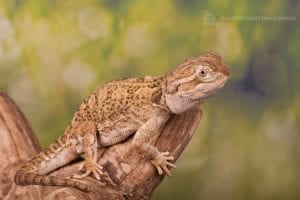Rankins Dragons are very similar to Bearded Dragons, only smaller – a maximum total size would be around 30cm. For this reason they are a popular lizard to keep as pets – but much less common to see for sale in pet stores. The expected life span is around 6-10 years, as long as they have their needs met correctly. They naturally occur in the Queensland area of Australia in dry arid areas.
 Like Bearded Dragons, this species is relatively easy to maintain successfully – as long as some simple conditions and procedures are catered for. As they are smaller than Bearded Dragons they will require a smaller vivarium – an absolute bare minimum for one adult is a 3 feet long vivarium, with a four feet long one being much better as a minimum. Height should be around 2 feet tall plus – although not arboreal they will occasionally climb if branches are provided. Ventilation must be provided with top and bottom vents to provide good airflow. There must be a choice of hides provided, in various temperature ranges and a suitable desert style substrate on the floor. A small water bowl must have fresh water added each day.
Like Bearded Dragons, this species is relatively easy to maintain successfully – as long as some simple conditions and procedures are catered for. As they are smaller than Bearded Dragons they will require a smaller vivarium – an absolute bare minimum for one adult is a 3 feet long vivarium, with a four feet long one being much better as a minimum. Height should be around 2 feet tall plus – although not arboreal they will occasionally climb if branches are provided. Ventilation must be provided with top and bottom vents to provide good airflow. There must be a choice of hides provided, in various temperature ranges and a suitable desert style substrate on the floor. A small water bowl must have fresh water added each day.
Much like Bearded Dragons they require hot and dry conditions within their vivarium. It’s important to provide what is known as a thermal gradient within the vivarium. This simply means that the heater should be placed at one end of the vivarium so that a hot end and a cool end is provided so the Dragon can choose the temperature he likes throughout the day. A hot end basking temperature should be around 34C, with cooler areas – for around twelve hours during daylight hours. Night time temperatures can drop to around 18-20C within all of the vivarium. There is much debate nowadays on the kind of heater to be used for this purpose – with some keepers being very blinkered on their choice being the best and most suitable. Arguments are commonplace for and against the use of incandescent bulbs, ceramic heaters and halogen bulbs with objective pro’s and con’s for all. Whichever you choose it must be connected to a thermostat that controls the heat output so the Dragon is not over heated or killed. Some thermostats control day and night temperatures – and even the UVB lights too. Speaking of which, UVB lighting is a must – and it must be on for around twelve hours during the day and off at night. There are three main types of UVB lights commonly used T8 fluorescent tubes, T5 fluorescent tubes and Mercury Vapour bulbs. We personally use T5 tubes, and find these to give the most benefit in the most ways. Don’t forget, without a source of UVB the Dragon will not be able to effectively use Vitamin D3 in their system, and will become poorly with metabolic bone disease (MBD).
metabolic bone disease (MBD).
This species is omnivorous – please ensure that they are given a well-balanced mix of livefood (insects) and of “greens” such as kale and dandelion leaves. They will often prefer livefood and ignore greens if allowed – possibly leading to obesity and other health issues. Livefood is now available commercially in an almost bewilderingly wide range such as various crickets, locusts, cockroaches, Calci-worms, waxworms, morio and many others. Please ensure a good mix is provided, and that it is supplemented with a good quality vitamin and mineral supplement. Please remember to “gut-load” all livefood – this is just feeding the livefood with a good quality diet full of everything the Dragon also needs as they eat the livefood. There are several gut-loading livefood diets on the market.
This little lizard species is a gem to keep, and amongst one of our all-time favourite lizards – highly recommended.
